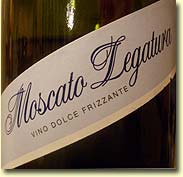 NV Mionetto Valdobbiadene Moscato Legatura
NV Mionetto Valdobbiadene Moscato Legatura
(100% Moscato; Colli Vicentini-Vicenza, Italy; Moscato Dolce del Veneto
IGT; Frizzante: 2.5-3.5 atm of pressure; $10-15 US)
I normally try to buy and drink my sparkling Italian moscatos fresh, but
Mionetto makes it hard as they don’t date their bottle and it can be
hard to tell if the stock on the shelves is fresh or not. Because of
that, I often shy away from it unless I can get confirmation on the
bottle’s age. Mad sparkling scientist that I am, I wondered how this
wine would change over a few years so I bought a couple bottles during
the Christmas holidays in 2003 and let them sit in the cellar until now.
Mionetto recommends drinking within 3 months of purchase. Whoops, I
guess I interpreted that as drink within 3 years. So, how does it taste?
The first thing you notice when you pick this bottle up is that the cork
is held down by a string. This is done to pay homage of how they used to
bottle wines in ancient Venice. The second thing you may notice (once
you pour it) is that it isn’t very lively with the bubbles. That is
because it is a Frizzante or slightly sparkling wine. While most
Champagnes have a pressure of around 6 atm, Frizzantes (also known as
Petillants) have a pressure of 2.5 – 3.5 atm. This means that they have
a much gentler mousse, less numerous bubbles, and much smaller bubble
size. But, how does it taste?
Sweet honey, apricot, and baked piecrust lead the way and get me
excited. On first impression, this is much sweeter and more concentrated
than I anticipated but the excitement over the nose is quickly dulled by
a strange aroma of stale, dry oranges that are just starting to go
rancid. It isn’t horrible, but it is a bit worrisome to me. As for the
palate, it is an improvement over the nose. Surprisingly this tastes
like someone mixed a Sauternes, a Moscato d’Asti, and a well aged blanc
de blancs Champagne together. Initially, it shows some concentrated
honeyed apricot and peach notes floating over a backbone of sweet,
light, and fluffy peach and apricot citrus. Eventually the concentrated
flavors fade from the backbone and some butterscotch and apple pie notes
replace them and lead into a sweet syrupy citrus and apricot finish. It
is rather odd; I can’t say it is a bad or enjoyable trip, but it
is an interesting one.
While I would have no problem enjoying a glass of this, it clearly was
never intended to age or taste this way. It is beginning to go over and
it tastes nothing like a young and refreshing sparkling Moscato should.
It is heavy, cloying, and, again, just plain weird. So would anyone
really enjoy this? To me, with a few years of age, it turns into the
sparkling Moscato for lovers of well-aged Champagne who cannot stand any
Champagne until it turns 20. However, for myself, I would rather have my
sparkling Moscato fresh any day. Grade of C (73-75 pts) for this “aged”
bottle. When served young, this is a grade higher and gets a Grade of B
(83-85 pts). Find this wine
NV Jaume Serra Cristalino Extra Dry Cava
(50% Macabeo, 35% Parellada, 15% Xarello; Spain; $5-9 US)
A rather light and dull nose is the first impression. There are some
sweet aromas, but overall it is highlighted by blunted citrus flowers
and bland fluffy dough. It isn’t giving me any clue as to how the palate
tasted. The palate, however, does give me a nice dose of flavor. Lots of
fluffy cotton candy and powder sugar is sprinkled on a small serving of
pears and peaches. There is a nice citrus streak along with minerals and
some creamy dough notes that weave there way in with the sweet flavors.
Overall, this is a solid wine that is a good buy for the price. It isn’t
anything special and doesn’t move me, but for $5, it isn’t bad.
Personally, I pick up the Rose and Brut over this, but others enjoy the
sweet touch of the Extra Dry. I admit that I do buy Cristalino for
certain functions and I drink it too. Grade of C (73-76 pts). Find this wine
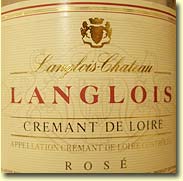 NV Langlois-Chateau Cremant de Loire Rose Brut
NV Langlois-Chateau Cremant de Loire Rose Brut
(100% Cabernet Franc; Loire Valley, Samur; France; Methode Traditionelle;
12 hours of maceration to give the wine its color; 18+ months of aging
on its lees; 12.5 % alc; Disgorged 2006; $20-25 US)
It is not often that I turn to the non-Champagne regions in France for
my sparkling wine fix, but this bottle was recommended so I gave it a
go. Bollinger has a controlling interest in Langlois-Chateau so you know
that quality will be “Job 1” at this producer. And just like at
Bollinger, Langlois-Chateau exceeds any requirements for Cremant de
Loire and proudly displays their requirements on the back label of the
bottle.
When you first grab a glass of this wine, its lovely eye catching shade
of pink is impossible to ignore. Along with Banfi’s Rose Regale
Brachetto d’Acqui, this has to be one of the most romantic looking
sparklers. The rolling mousse and tiny bubbles don’t do any harm to its
looks either. As strange as it sounds, I just like staring at this wine.
But I can’t just stare at it, I have to try a taste too. So, try it I do
and it gives off doughy strawberry and citrus mineral notes on the nose.
Just as the color exudes romantic elegance, the nose is light and
elegant as well. A slightly fluffy sweetness winds its way through the
palate and mixes with ruby red grapefruit and red tinged mineral notes.
Following these flavors is a very clean finish with fluffy dough, red
citrus, and minerals bringing the wine home.
This is quite an impressive Rose for around $20. It definitely has a
Champagne feel to it and if you like your Champagnes in an elegant red
citrus mineral driven style then this is likely to be a bargain to you.
If I was having a party and needed an elegant $20 and under Rose that
was made in the style of Champagne, this would be on my short list. It
is a quality wine and while it isn’t quite Champagne, it is close.
Grade
of B- (80-82 pts). Imported by Paterno Wines International Find this wine
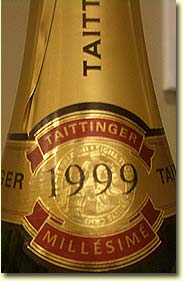 1999 Taittinger Brut Millesime
1999 Taittinger Brut Millesime
(50 % Pinot Noir, 50% Chardonnay; Disgorged ~ late 2004; $50-65 US)
Taittinger’s Millesime has been a hit and miss for me throughout the
last two decades. I tend to really enjoy it in top vintages like 1985,
1988, 1990, 1995, and 1996, but I usually find it lacking in less
impressive vintages like 1983, 1986, 1992, and 1998. The 1999 was not an
impressive vintage despite what propaganda Taittinger may put out on
their website. For instance, Taittinger says “The 1999 vintage could be
likened to the 1982 or 1988 vintages”. I don’t think so. The only
similarity between 1999 and 1982 or 1988 is that Taittinger made a
vintage wine in each. With this background, I ventured cautiously into
this bottle not knowing what to expect.
A rather expressive nose of fluffy, peachy earth, flowers, creamy dough,
and an impressive citrus mineral streak kicks this wine off. I’m not
exactly sure that I’m digging what it is saying to me, but it has me
interested. Chalky minerals, tight citrus and a good dose of gently
spiced bread dough greet my palate. I still find notes of fluffy earth
that can weigh a wine down, but this manages to keep it together
and stay light on its feet despite its medium body. That may be hard to
grasp, but picture an NFL Tight End who has the speed and quickness to
get away from smaller defensive backs.
It is surprisingly mineral driven and this along with creamy, tingling
citrus notes make for a very nice finish.
I have to admit that with the first couple glasses, I would have guessed
that Taittinger had included some Pinot Meunier in this wine. It has the
fluffy, peachy, earthy signature of Pinot Meunier, but it is all
Chardonnay and Pinot Noir. The citrus minerality and creamy dough notes
show just how great the Chardonnay in this wine is. That leaves the
Pinot Noir as the dog but I think some time will smooth this out. A
taste on day two proves this point as the wine shows a much more
balanced attack with juicy pears, creamy citrus, and dough notes. Some
may have a problem with the high level of sweetness, but I think that
will help it come together and evolve over time. Overall, this wine
exceeded my low expectations for a Taittinger non-great vintage release,
but I still don’t think it is good enough to pick up at its current
price point. There is too much other stuff out there that is better at
the same price point or less. If you do
choose to buy this, I would leave it in the cellar for 4-5 years. It
will be better then. George has already
reviewed this wine and I think
we are both on the same page with this. Grade
of Low B (83-85 pts) with the potential to move up a more solid B (84-86
pts) in 4-5 years. Imported by The Kobrand Corporation, New York, New York Find this wine
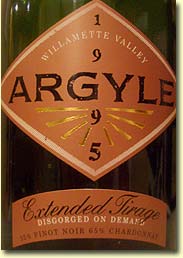 1995 Argyle Extended Tirage Brut
1995 Argyle Extended Tirage Brut
(65% Chardonnay, 35% Pinot Noir; Williamette Valley, Oregon; Disgorged
early 2006; 634 cases produced; $35-45 US)
I’ve always had a strange relationship with Argyle. I normally enjoy the
basic vintage and blanc de blanc wines, but sometimes have problems
wrapping my arms around the rose, single vineyards, and extended triage
wines.
This wine shows a very active mousse and a nose of sweet cream, light
citrus blossoms, and cornbread. I wasn’t expecting the cornbread notes,
but I did go to school in Texas so it brought back bittersweet dormitory
cafeteria memories. The palate shows a core of extremely tight citrus,
sweet cream, and a very faint off-putting note of paint thinner.
Together they do not make a wining team. Also, despite the citrus being
tight and concentrated, it is leaves you with an empty feeling; it is
almost like something is missing or is not quite right. While this shows
very young for being an 11-12 year old new world sparkler, it oddly
lacks any of the leesy notes that I would expect from a wine disgorged
this late in its life. I’m also not a fan of the finish as the
concentrated citrus and cream seem to be in a death battle to suck the
last bit of moisture from your mouth.
This is one heck of a strange wine. I really liked the cornbread nose,
but the palate wasn’t up my alley. I applaud Argyle for experimenting
with these late disgorged wines (i.e., please stop releasing them and
concentrate on what you do well), but I think you get much better
results by storing an original disgorgement for 5-8 years past its
vintage. The wines can take the age and show much better complexity
without the odd notes that the late disgorgements show. They are less
expensive too. Grade of C+ (77-79 pts). Find this wine
 NV Vicomte de Castellane Brut Rose
NV Vicomte de Castellane Brut Rose
(60% Chardonnay, 40% Pinot Noir; 15% Red Wine Addition of Pinot Noir;
Disgorged 2004; $25-35 US)
Colors of pale copper and salmon make this an attractive Rose to look
at, but unfortunately looks don’t make a wine. The nose isn’t so bad as
it shows some strawberry biscuit and cream notes, but it doesn’t exactly
enthrall you. After the nose, it is all downhill as stale oranges,
bitter minerals, and strawberry biscuits made by someone who can’t
follow directions are the high or lowlights of this wine. A thin and
easy to forget finish leaves me yawning and reaching for a different
bottle. On the positive side of things, at least it is on the low end of
price scale. Overall this is a boring, bland, and not so tasty wine.
Give me a solid non-Champagne Rose sparkler over this any day.
Grade of
C- (70-72 pts). Find this wine
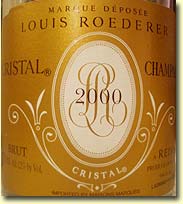 2000 Louis Roederer Cristal Brut
2000 Louis Roederer Cristal Brut
(55% Pinot Noir, 45% Chardonnay; 11-12 g/L dosage; Some oak aging;
Disgorged 2006; $175-275 US)
This bottle was sampled over two days and remained consistent
throughout.
Ah yes, the famous Cristal. This is the follow up to the classic 1999 so
it has some big shoes to fill… and leave them empty it does. A lemon and
ginger nose shows that this wine is still young, but other than some
light graham cracker aromas, it is a bit empty. As for
how it tastes, semi-sweet (this is less sweet than past vintages of
Cristal) and very concentrated lemon and orange lead the charge. The
second line contains some bitter minerals and under ripe pears, but that
is about it. On day 2, some apple notes join in with the pears and clean
concentrated citrus notes, but not much else seemed to be going on. It
does have a finish, but the drying concentrated bitter citrus flavor
isn’t anything special. The second day saw the finish improve slightly
as the drying aspect disappeared, but when all you can give is clean,
bitter citrus notes, I can’t help but feel empty.
There isn’t much more to say. This is a solid wine, but is devoid of a
soul and comes with a ridiculous price tag. If I were Louis Roederer and
charging this much for this wine, I would recall it all and send a
refund along with apology letter to every customer. This is blasphemy
for the price. It isn’t a bad wine, but it shouldn’t be more than
$50-$60 and when you charge north of $200, expectations are a bitch. Why
in the world anyone would buy this when you can still find the mind
blowing 1999 I don’t know. In fact, this would be slightly disappointing
even as the Louis Roederer basic 2000 vintage wine. Just one more data
point that shows anyone claiming the 2000 vintage is anything more than
average (i.e., use the wine for non-vintage blends and not to make
vintage wines) needs to be committed. Grade of B (84-86 pts). Find this wine
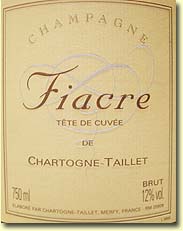 2000 Chartogne-Taillet Fiacre
2000 Chartogne-Taillet Fiacre
(60% Chardonnay, 40% Pinot Noir; Merfy; Malolactic Fermentation done as
needed; Disgorged March 2006; $50-80 US)
This old vine tete de cuvee from Chartogne-Taillet has been a knockout
the last couple vintages I tried (1996 and 1999). The 2000 had received
a large amount of hype so I was chomping at the bit to pop a bottle. I
haven’t been big on the 2000 vintage so I was hoping this would
help to alleviate my fears about the vintage being mostly a rip off of a
declaration. I opened two bottles of this alongside the 2000 Cristal
reviewed above and, as with the Cristal, enjoyed it over two days.
Initially, very large aromas of apple blossoms, waxy apple skins, and
raw oatmeal fill my nose. It smells young and is quite enticing. Over
time, it calms done a bit, but raw, waxy notes remain strong. The palate
is quite dry and is rather strange in flavor. It is best summed up by
comparing it to biting into sliced, under ripe apples and pears that
have had lemon juice squeezed on them. Also, the skins on the fruit are
coated with wax and a tiny bit of glue from the product sticker remains.
Odd, indeed. In addition to these flavors some peppery apple juice makes
an appearance as the wine fades into a clean, steely, chalky, mineral
laced finish. On day 2, the wine improved quite a bit as creamy sweet
oats entered the picture, but the off-putting waxy, glue-like, resinous
flavors were still up close and personal.
This wine needs more bounce to its ounce in the fruit department and
needs to shed its waxy, glue laden skin. I think some time will help
even it out, but won’t make it much better. At the same point in their
lives, the 1996 and 1999 vintages were much better and will
always be better wines. The 2000 just doesn’t bring the bacon home.
Don’t believe the hype on this one. Pick up the 1999 while you still
can. It is a much better wine. On the positive side, this was very
similar in quality to the 2000 Cristal and costs 3-4 times less.
Grade
of B (84-86 pts). Find this wine
With a Mexican inspired tortilla bake, I decided to pop some Cava. So
Cava is made in Spain and the food was an American bastardization of
Mexican fare. It doesn’t matter; it was an excuse to open some bubbly
and I am glad I did. I had not had anything from Raventos i Blanc
before, but they came highly recommended.
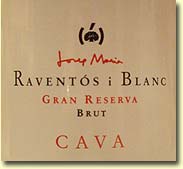 2002 Raventos i Blanc Gran Reserva Brut Cava
2002 Raventos i Blanc Gran Reserva Brut Cava
(35% Macabeu, 40% Xarel-lo, 20% Parellada, 5% Chardonnay; 100% Estate
Vineyards: Vinya del Llac, La Plana, El Serral, La Barbera, Vinya Gran,
El Viader; 11.5% alc; Disgorged 2nd Half 2006; $25-30 US)
A very delicate and attractive nose of fresh picked peach blossoms
floating in citrus spiked mineral water. Initially this shows an
incredibly tart palate that doesn’t give much more than lemon led
citrus, however with time, it fills out quite nicely. A dollop of
slightly fluffy citrus cream mixes with lemon and peach sorbet and a
nice glass of mineral water. This is very clean and surprisingly shows
better with warmth. I view this as a positive as you can sometimes chill
a sparkler until you numb any good to make the overpowering bad
hibernate. When you do this, you end up with a dull, bland, boring, cold
drink, but at least it is palatable. Much of the Cava I have tasted has
shown better numbed, but not this bad boy. Perfect with tapas or paella,
this is a simple and enjoyable Cava. Give it some time to breathe and
don’t over chill. It will reward you. This is an enjoyable bottle, but
the price is a bit high. If it was found more often at $20 US this would
be a buy, but at $25 and higher, I’m not sure. I wish I lived in Europe
or Spain where this can be found for under 15 Euros.
Grade of B- (81-82 pts).
Imported by Michael Skurnik Wines Find this wine
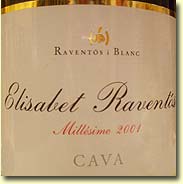 2001 Raventos i Blanc Elisabet Raventos Cava
2001 Raventos i Blanc Elisabet Raventos Cava
(60% Xarel-lo, 30% Chardonnay; 10% Monastrell;; 12% alc; Disgorged 2nd
Half 2006; 32,778 bottles produced; $30-45 US)
The cuvee Elisabet Raventos is the second highest Cava that Raventos i
Blanc releases. Only the Gran Reserva Personal Cuvee Manuel Raventos is
higher up on the totem pole. I had never paid this much for a Cava
before so expectations were high.
Very different from the above Raventos i Blanc Cava, this is much darker
in color and shows a nose of dough, cream, and touches of nuts and
honey. It shows little fruit and is quite dry. I really am not sure how
to read this based only on the nose. Once in my mouth, it also shows a
much bigger body and more complexity than the Gran Reserva reviewed
above. Lots of lemon and minerals mix with cream and slightly nutty
honey notes to form the core palate. In the back, some peach and candied
apricot dance in the dark. At first, I could not tell this was a Cava,
but then the light, clean, fluffy lemon and mineral finish came in and
said, “I am Cava, but I am a damn good Cava”. This is a pretty good
drink. It is one to sit back and reflect on. I’m not sure it is worth
the tariff, but it is interesting and shows what can be done in Cava
land. It also meshes with many dishes quite well. I’d be more
comfortable with this at the $25-$30 mark, but regardless this is a very
good sparkling wine. Heck, I like it almost as much as I do the 2000
Louis Roederer Cristal. In Europe, this runs 20-25 Euros.
Grade of Low B
(83-84 pts). Imported by Michael Skurnik Wines Find this wine
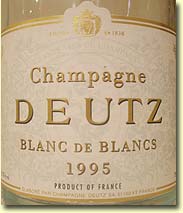 1995 Deutz Blanc de Blancs
1995 Deutz Blanc de Blancs
(100% Chardonnay; Vineyards: 40% Le Mesnil-sur-Oger, 50% Avize; 10%
Villers Marmery; Malolactic Fermentation done as needed; Disgorged 2000;
$50-75 US)
This bottle had been kicking around for a while and I can’t recall
giving it a go, so it was hard to resist the beckons of, “open me” from
the depths of my temporary makeshift cellar.
A very lovely pale yellow color shines through the clear glass like
sunshine in a bottle. The nose shows aromas of creamy citrus, dough,
pears, minerals and a bit of nutty maturity. It seems to be on the cusp
of change as both childhood and teenage notes are present. Regardless of
whether I like a wine, I always enjoy this characteristic as it shows
you where it has been and where it is going. A wine whose voice is
cracking can be a bit hard to enjoy, but catching a wine at its
transition can be great learning experience. The palate is showing much
younger than the nose with only light transition period characteristics.
Tightly wound lemon flavored mineral water mixed with fresh toast and a
slightly creamy and very light Fino Sherry note make up a very crisp and
enjoyable flavor profile. This is not a wine that will bowl you over,
but it is enjoyable in it’s final glimpses of youthful crispness and
freshness. I’d pop a bottle on a hot day this summer or store it for
another 5 years and let it blossom into maturity.
Grade of B+ (87-88
pts). Find this wine
While I am a lover of Moscato d’Asti, I’m not much of an Asti drinker
and I can’t recall the last time I tried to critically evaluate an Asti
bottle. My sister works for Bacardi USA (who imports Martini & Rossi)
and is constantly telling me how their Asti is so much better than the
slightly less expensive Tosti. I figured it was time to see what she was
talking about and have a few glasses.
So what are the similarities and differences between Asti and Moscato
d’Asti?
Similarities
-
Both are made from the Moscato Bianco grape
-
Both are best enjoyed young
-
Both are sweet sparkling wines (somewhere around the Demi-Sec level or
sweeter (> 33 g/L of residual sugar)
Differences
-
They are grown in different appellations (Moscato d’Asti or Asti)
-
Asti is a full Champagne pressure level sparkling wine (5-6 atm)
-
Moscato d’Asti is much less sparkling and is known as a Frizzante or
Frizzantino sparkler with a pressure of 0-3.5 atm.
-
Asti is made via the cuvee close method which is better than the Methode Champenoise
for sweet, fruit filled, aromatic wines that are not meant to age
-
Moscato d’Asti is normally made by bottling the wine while it is in
the midst of its first fermentation.
-
Moscato d’Asti is normally sweeter and more expensive than Asti
-
Asti is much more common (by almost a 30:1 ratio) than Moscato’Asti
Please note that bottle variation on mass market Asti can be high due to
the production numbers and also because this is a wine that really needs
to be enjoyed young and fresh. Many times what you find on the shelf is
not so fresh and that can affect things. For these reasons, my scoring
range is quite wide on these bottles. I purchased fresh bottles of each
wine from different locations to try and get a solid read on these (2
Martini and Rossi Astis and 3 Tosti Astis – more Tosti was purchased
just to make sure what I was tasting was what they intended me to
taste).
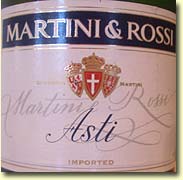 NV Martini & Rossi Asti
NV Martini & Rossi Asti
(100% Moscato Bianco; Asti; Cuvee Close Method; 8% alc;
$9-12 US)
Sweet peach nectar and apricot blossoms fill your nose and lead into an
equally sweet palate. A light and fluffy mouth feel matches very well
with the sweetness. I can only describe the predominant flavor as nectar
of Sprite. Lovely concentrated lemon-lime notes mix with nice acidity
and light floral notes. It finishes up with sweet apricots kissed by
citrus juice. I don’t mind this wine and would gladly drink it. Yes, it
is a simple sweet quaffer, but it has a zesty personality and a nice
dose of acidity to match the sweetness and keep it light on its feet.
Grade of C+/B- (77-82 pts). Find this wine
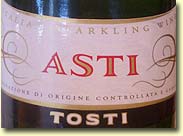 NV Tosti Asti
NV Tosti Asti
(100% Moscato Bianco; Asti; Cuvee Close Method; 7.5% alc;
$7-10 US)
A very sweet nose of syrupy peaches mixed with orange and apricot had me
thinking that this would be a wine of extreme sweetness with some
balance, but it was not to be. The palate on this runs off in a
different direction from the nose as a surprisingly heavy body weighs it
down. It shows good sweetness, but it doesn’t show much of a
distinguishing fruit character and lacks any acidity or zestiness to
balance the sweetness out. It does show some off-putting, bitter plastic
notes, but that isn’t the balance I was looking for. The finish is also
bitter and where the Martini and Rossi is nectar of Sprite this is
nectar of a Sprite can. I know bottle variation is high, but there
seemed to be a metallic trend among my bottles. This just isn’t a very
good Asti in my book. Too simple, too sweet, and too much plastic and
metal. Grade of D+/C- (67-72 pts). Find this wine
Cheers!
Brad Baker
BACK TO THE TOP
BACK TO BRAD BAKER'S
INDEX PAGE
March 2007 © Brad Baker

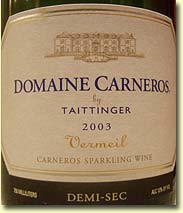 2003 Domaine Carneros Vermeil Demi-Sec
2003 Domaine Carneros Vermeil Demi-Sec NV Mionetto Valdobbiadene Moscato Legatura
NV Mionetto Valdobbiadene Moscato Legatura NV Langlois-Chateau Cremant de Loire Rose Brut
NV Langlois-Chateau Cremant de Loire Rose Brut 1999 Taittinger Brut Millesime
1999 Taittinger Brut Millesime 1995 Argyle Extended Tirage Brut
1995 Argyle Extended Tirage Brut NV Vicomte de Castellane Brut Rose
NV Vicomte de Castellane Brut Rose 2000 Louis Roederer Cristal Brut
2000 Louis Roederer Cristal Brut 2000 Chartogne-Taillet Fiacre
2000 Chartogne-Taillet Fiacre 2002 Raventos i Blanc Gran Reserva Brut Cava
2002 Raventos i Blanc Gran Reserva Brut Cava 2001 Raventos i Blanc Elisabet Raventos Cava
2001 Raventos i Blanc Elisabet Raventos Cava 1995 Deutz Blanc de Blancs
1995 Deutz Blanc de Blancs NV Martini & Rossi Asti
NV Martini & Rossi Asti NV Tosti Asti
NV Tosti Asti